
Eyes on Christ | Vol. 18, Issue 32 | July 23, 2025 | Ordinary Time (After Pentecost)
Welcome to Eyes on Christ! We are exploring the rights of nature and ‘buen vivir’ through creation and origin stories from around the world, including biblical narratives. The goal is to enjoy "life's offerings," as a reader recently expressed, while growing stronger in the faith.
Today’s two wolves story is a legendary and recurring motif in modern literature, and the 1995 reintroduction of wolves in Yellowstone Park is an inspiring story of ecological change. I dedicate it as a birthday tribute to a young man, a faithful supporter of Eyes on Christ.
The Two Wolves Within
Ecological Reintroduction and the Human Heart
One evening, as they sat by a fire on the shore over there, the Cree elder told the Abbot something that had happened to him when he was a child. His grandfather, the Chief at the time, told the boy that he had two wolves at war inside him, tearing at his insides. One of them, a grey wolf, wanted the old man to be strong and compassionate. Wise and courageous enough to be forgiving. The other, a black wolf, wanted him to be vengeful. To forget no wrong. To forgive no slight. To attack first. To be cruel and cunning and brutal to friends and enemies alike. To spare no one. Hearing this from his grandfather terrified the child. He ran away. It took a few days before he dared approach the old man again. When he did, he asked his grandfather, ‘Which wolf will win, the grey or the black?’ His grandfather said, ‘The one that I feed.’ We all have them, inside. Best to acknowledge that. Only then can we choose which one we feed. - Louise Penny, The Grey Wolf.
Canadian author Louise Penny’s latest mystery novel, The Grey Wolf, was published last year. I enjoy reading Penny’s Inspector Gamache series for her elegant writing, realism, and creation of complex characters and moods. Her use of dualism to convey powerful ideas often stirs reflection. In this story, she attributes the metaphor of two wolves living inside people to the native Cree people of Canada and promotes it as wisdom. The grey wolf symbolizes forgiveness, while the black wolf is the avenger.
The habits of forgiving versus non-forgiveness, wishing ill upon those who harm us, and forgetting past wrongs versus nursing grievances and seeking revenge, exist not in black and white but in many shades of grey. We may not seek justice or revenge, but negative feelings can still lurk beneath our consciousness or be actively repressed. The grey and black wolves inside human hearts don’t quite make ordinary people into stark saints and sinners as Penny’s story appears to portray them. They are nuanced creatures, as her own book and closing lines reveal. Do all readers grasp this nuance? And it is in this context that I asked myself: What does the Bible tell us about good and evil, and forgiveness?
Before answering, I explore this: What does the Bible say about the human heart?



